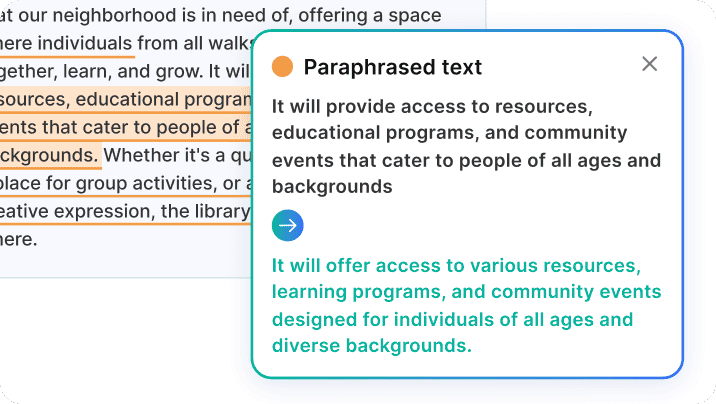I’ve lost count of how many times students have asked me, “What’s the difference between summarizing and paraphrasing?” It’s a fair question. On the surface, they seem pretty similar: both involve reworking existing information. But when you’re actually writing an academic paper or preparing a report, knowing which one to use (and how to do it right) makes all the difference.
Whether you’re a student trying to avoid plagiarism or a professional aiming to write more clearly, understanding the subtle differences between these techniques will give you an edge.
Let’s break it down the way I usually explain it and see how paraphrasing tools can help you.
What Is Paraphrasing?
Paraphrasing is when you take someone else's idea and restate it in your own words, without shortening it. You're still including all the original details, just changing how they're expressed.
Here’s an example of paraphrasing:
Original: “Daily exercise improves mental health by reducing anxiety and boosting self-esteem.”
Paraphrased: “Working out each day can ease anxiety levels and help people feel better about themselves.”Same idea, different wording. The meaning stays intact, but you’re using your own language. It’s useful when you want to simplify complex sentences or better match your writing style.

What Is Summarizing?
Summarizing is all about condensing. You’re taking a large chunk of content (maybe a whole paragraph or even a few pages) and boiling it down to the most essential points.
Here’s an example of summarizing:
Original: “Many experts agree that consistent sleep schedules, reduced screen time, and mindfulness exercises can help teenagers manage stress levels during exam periods.”
Summary: “Healthy habits can lower teens’ stress during exams.”See the difference? You’re not rewriting the whole thing; you’re capturing the core idea in a few words. Summaries leave out details, while paraphrasing keeps them in.
What’s the Difference Between Summarizing and Paraphrasing?
Here’s the simplest way I explain it. Paraphrasing is like saying the same thing in your own voice. Summarizing is like stepping back and saying, “Here’s the big picture.”
Both are useful in different situations. I often paraphrase when I want to explain a specific idea without quoting directly. I summarize when I need to give a quick overview, especially when dealing with long articles or chapters. When to use each? I usually recommend using paraphrasing when you want to clarify a complicated sentence from a source. Also, when the idea is important, but quoting it directly would be clunky. Or if you’re weaving outside info into your own argument or explanation.
In contrast, it's better to use summarizing when the full text is too long to include in your writing, or you only need to highlight the main point. Also, summarizing is good when you’re giving a quick reference or overview.
Getting a feel for when to use which takes practice, but once you do, your writing becomes more natural and professional.
Why This Matters More Than You Think
Plagiarism is one reason, of course. But beyond that, if you can’t paraphrase or summarize effectively, your work risks becoming either too bloated or too reliant on quotes.
I’ve seen this especially in academic writing, when some students try to sound “smarter” by quoting everything. But real mastery comes from being able to process information and express it in your own way. That’s what these skills are all about.
How JustDone Helped Me Level Up My Process
There was a time when I’d get stuck trying to rephrase technical passages for blog posts or student resources. That’s when I started testing out JustDone’s tools. Their paraphrasing assistant doesn’t just swap words; it gives smart suggestions that help preserve meaning. I still rewrite and tweak things myself, but it saves me time and gives me a fresh starting point.
Another moment where it really helped? Summarizing research papers. When I’m short on time but need to grasp the gist of a study or article, JustDone’s summarizer gives me a solid draft that I can refine.
I mention this not to hype a tool, but because we all need support when deadlines are tight and ideas aren’t flowing.

My Go-To Strategy for Students and Writers
Here’s what I always tell people when they ask how to get better at paraphrasing and summarizing:
- Read actively. Don’t just skim. Understand the message before rewriting anything.
- Write it out from memory. Close the original, jot down what you remember. That forces you to use your own words.
- Compare and revise. Then go back, check accuracy, and clean it up.
- Avoid patchwriting. Don’t just change a few words here and there. That still counts as plagiarism.
- Practice with different kinds of content. Articles, TED Talks, textbooks—each one stretches your skills in a new way.
Final Thoughts on Paraphrasing vs Summarising
If you’ve ever asked yourself, “What is the difference between summarizing and paraphrasing?”, I hope this guide cleared it up. Paraphrasing keeps the details, summarizing trims the fat. Both require understanding. Both take practice.
And honestly, tools like JustDone can make that practice smoother. They’re not a crutch; they’re a support system for real learning. So next time you’re working with source material, ask yourself: Do I need to rephrase or condense? And then move forward with clarity. It’s a small shift that makes a big difference in how you communicate—whether you’re writing for a grade, a client, or your own growth.